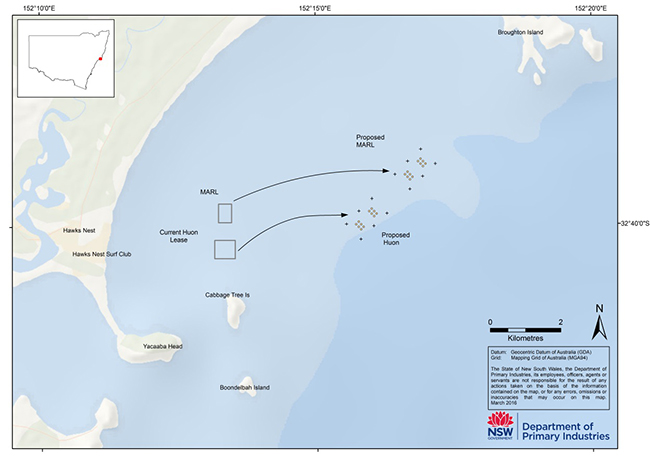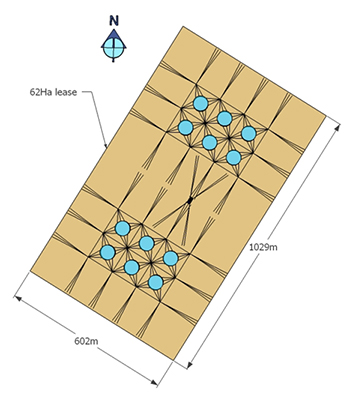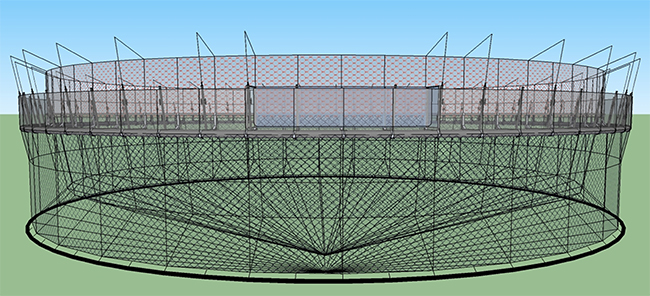
Aquaculture Lease Modification Application Q&A
In 2013 NSW DPI released an Expression of Interest seeking a partner to work with it on the approved offshore Research Lease.
Huon Aquaculture Group Limited (Huon) was selected as the preferred research partner to work with NSW DPI. Huon subsequently purchased the nearby Pisces commercial lease in 2014.
The current technology used in the Australian aquaculture industry has improved significantly since the Pisces proposal was lodged for assessment in 2001, and even compared to the Research Lease application lodged in 2012. These changes include pen size, materials and construction technology, predator exclusion and feed management.
There is also a trend to move sea pens further offshore into deeper waters away from the coast to further reduce environmental impact and create a better growing environment for the fish, Figure 1.

Figure 1: Approved lease areas and proposed new lease sites (Source: NSW DPI, 2015)
The proposed modifications will allow the use of leading edge technology and farming practices and improves the capacity of the Research Lease to provide commercially relevant research results. This will result in better economic, environmental and biosecurity outcomes.
Initially, only 2-3 sea pens will be placed on the Research Lease to monitor and develop the project in stages.
The key modifications are to relocate the two leases further offshore into deeper water, increase the number (8-10 to 12) and size of pens, expand the area of the leases to accommodate mooring lines and add permanent feed management systems to each lease site. The changes will result in a reduction in the stocking density of fish.

Figure 2: Proposed new lease layout (Source: Huon, 2015)
The approved modifications are consistent with the original consent conditions that put in place checks and balances to ensure sustainable aquaculture. The most significant change is relocating the leases further offshore.
Another change would be to utilise the Port of Newcastle to support some activities such as the cage construction and the weekly supply of feed from a waterfront land based depot. This would reduce motor vehicle and boating traffic within the Port Stephens area.
The approvals to operate both the Huon and the Research Lease were granted by the Department of Planning and Environment.
The Department made this decision based on: a formal application and environmental assessment of the proposed changes; submissions made by agencies and the community during the project exhibition period; and a Response to Submissions report prepared by NSW DPI and Huon.
During the exhibition period there were 18 submissions made: nine supporting the project; three agency comments and six objections or comments.
Yes, the Research Lease will investigate and develop new technologies for the marine aquaculture industry.
Key outcomes from the research will be: proving the suitability of species such as Yellowtail Kingfish; developing diets; validating equipment and technology; and undertaking environmental monitoring.
The modifications will allow for more commercially relevant research results.
- See a diagram of seafloor mapping of the proposed lease sites (Source: NSW DPI, 2015)
No, five years after commencing works on the Research Lease NSW DPI’s tenure is required to be terminated.
Information regarding the Research Lease will be made available on the NSW DPI and the Huon websites. Huon has structures in place to ensure community consultation is undertaken.
Their Sustainability Dashboard has current updates to inform the community about many aspects of their farming operations in Tasmania, such as growing conditions, fish health and environmental compliance.
Community feedback is also well received with a specific webpage that also has links to their social media platforms.
NSW DPI and Huon will provide regular updates on the project to stakeholders and local community and user groups.
Peter and Frances Bender began farming fish in Tasmania in 1987, starting with one sea pen and a lone employee. Since then Huon has evolved to become a fully integrated operation that produces approximately 20,000 tonnes of Atlantic Salmon and Ocean Trout each year. Employing over 500 people with operations across Tasmania and most Australian states, Huon has become an iconic brand for Tasmania and integral part of its cultural and economic landscape. For the 2013/14 financial year, Huon Aquaculture achieved a turnover of approximately $195 million.
NSW DPI and Huon believe that by moving into deeper water and adopting the latest technology for sea pen design, predator proofing and feed management, the risk to the environment will not increase. Relocating the leases to deeper water provides for stronger currents and increased water movement which is better for the fish and wider environment. Moving further away from Cabbage Tree Island is likely to reduce the risk to Goulds Petrel and seals, and reduce the visual impact for Hawkes Nest residents.
The proposed lease sites would occupy an area of 62 hectares each. The Research Lease and Huon sites will be 9 and 7 kilometres off the Tea Gardens Hawkes Nest Surf Club respectively.
The increased area is required to accommodate the mooring system required for deeper water.
The main infrastructure within each lease will be up to 12 floating, double collared sea cages with an anchoring system which have a diameter of up to 53 metres.
Other infrastructure would consist of a feed barge and navigation buoys on the corners of the lease areas in accordance with NSW Roads and Maritime Services requirements.
Yes. A monitoring buoy was placed in Providence Bay in 2015 to collect wave and current data. This has been linked to Bureau of Meteorology historic records and then used by international experts to ensure the mooring systems and pens will handle adverse weather conditions.

Figure 4: New ‘Fortress Pen’ (Source: Huon, 2015)
The modification will result in 11 full time jobs consisting of 6 research and 5 farm staff in Year One.
Also a number of contractors will be employed during the construction stage.
Experience with Huon in Tasmania also has shown beneficial outcomes for the regions tourism industry with farm tours and local sales of farm fresh seafood.
Given the presence of nets and mooring lines, recreational boaters, fishers, spear fishers should remain outside the lease areas for personal safety. Lease boundaries will be delineated by yellow cardinal markers. It is an offence to interfere or damage anything in the leased areas. It is planned to locate moorings for recreational fishers on the edge of the lease sites.
Yes. Huon are keen to ensure their products are easily available and well promoted in the local area and have entered into discussions with Newcastle Fishermen’s Co-operative, local seafood outlets and restaurants.
The use of the latest feed management technologies (hoppers/barge) to deliver feed with electronic underwater monitoring of fish feeding behaviour will prevent excess feed entering the surrounding waters. This will result in less nutrients being discharged into the surrounding environment.
- See a diagram of recreational fishing reefs in relation to proposed lease sites (source: NSW DPI 2015)
No. The proposed modification is to utilise the latest technologically advanced willife safe sea pens. These pens are specifically designed to prevent wildlife from entering the sea pens. The net design and material discourages birds from resting on the pens and prevents them from accessing fish feed reducing the likelihood of bird entanglements. If predators are unable to enter the sea pens and interact with the standing stock, the attractiveness of the leases to predators such as sharks and seals is greatly reduced.
The proposed lease sites will be in proximity to vessel routes used by offshore tourism and recreational boaters, fishers and divers traversing between Port Stephens and Broughton Island and nearby reefs.
This will result in the need for some vessels to slightly diverge on an offshore track to pass the proposed lease sites as they have been aligned to minimise as much as possible any disturbance to marine traffic.
A person standing on a beach can see out to sea for approximately 4.5 km. The proposed research and Huon leases are located 7.5 and 9.1 km from the Tea Gardens Hawks Nest Surf Lifesaving Club on Bennetts Beach. Consequently the distance offshore and low profile of the sea cage infrastructure and service vessels will result in a negligible impact on the visual amenity of Providence Bay.
The lookout on the summit of Mount Tomaree within the Tomaree National Park is located about 8.7 and 10.6 kms from the proposed lease sites. Cabbage Tree Island will predominantly obscure the leases from this vantage point.
The new sea pen and barge technology reflects the design features of the MARL EIS which aim to minimise the visibility of the infrastructure.
Following application, exhibition and finalisation of a Response to Submissions report a decision from the Department of Planning and Environment has approved the project.
The proposed lease sites are close to the previous commercial farm, have a more suitable depth with a sandy seabed, are close to Port Stephens Fisheries Institute, have the appropriate Marine Park’s zoning and are in NSW waters.
Seeking alternative lease sites would require a new application and may also involve legislative amendments to allow aquaculture in Commonwealth Waters.
Areas near Stockton Bight that might have a suitable depth and appear to be a suitable distance away from rocky reefs are in Commonwealth Waters.
The Port Stephens-Great Lakes Marine Park “is zoned for multiple use and protects marine habitats and species while catering for a wide range of sustainable activities”.
Oyster aquaculture has a long history in Port Stephens with some 50 businesses and over 600ha of current oyster leases. Farm gate oyster sales were worth $6.5m in 2014/15. Land based aquaculture (Barramundi, Silver Perch, Yabbies, hatchery) is represented by ten businesses producing over $2m annually.
In NSW there are over 1500ha of oyster leases operating in Marine Parks (including Sanctuary Zones), Nature Reserves, National Parks and Aquatic Reserves. The industry has long been an advocate for water quality protection and sustainable catchment management.
Initially cages of 38m diameter (120m circumference) will be used on the Research Lease and if the results are positive, cages of up to 53m diameter (168m circumference) may be used.
Initially Huon will use a 13m vessel for all operational work on the Research Lease.
The Research Lease has a five year tenure and the commercial Huon Lease has a fifteen year tenure. Ongoing approval to use the Huon Lease area is based on meeting stringent consent, permit and lease conditions.
Aquaculture in coastal NSW contributes significantly to provide fresh local seafood, as well as direct and indirect employment. In a recent survey, most visitors to the coast wanted local seafood and did not think aquaculture detracted from their holiday experience.
Over 60% of tourists wanted to visit an aquaculture farm and 75% of tourism operators agreed aquaculture was part of their local tourism product (University of Technology Sydney study on the social and economic evaluation of coastal aquaculture in NSW, in press). Experience elsewhere in NSW and Australia highlights the positive links between local seafood production and tourism industries, for example see Tasmanian Seafood Seduction.
Vessel movements and working on the sea pens will not be conducted 24 hours a day. Restrictions are in place to keep operations (except in an emergency) to daylight hours and lighting on the leases will be restricted to prevent impacts on sea birds while maintaining navigational safety. Initially feeding will be conducted by in-pen feeders operated by solar panels. A feed barge, if introduced, operates on batteries at night and is soundproofed so that daytime noise is reduced to 50m.
Port Stephens Fisheries Institute hatchery is accredited under the NSW Hatchery Quality Assurance Scheme.
The project will also develop a Fish Health Management Plan to provide for disease testing pre-release of fingerlings to sea pens, ongoing monitoring and disease response protocols.
Port Stephens Fisheries Institute has 34 locally caught Yellowtail Kingfish and is collecting more for its breeding program.
Using a large number of broodfish prevents inbreeding and ensures genetic diversity is maintained, such that if any fish escape from the sea pen they will not pose a threat to local stocks.
A low stocking density of fish will be used to reduce stress.
The stocking density has not changed from the original proposals and remains at a maximum of 12kg/m3.
Fish will take up less than 1% of the volume of the sea pens.
Using water current data and maximum feeding rates (e.g. for market sized fish) it has been calculated that any solids will fall within the lease area. Research undertaken with the Tasmanian Salmonid industry has shown the extent and likelihood of any impact around their sea pens.
The intent of the Research Lease is to gather monitoring data for Yellowtail Kingfish under NSW conditions to better manage performance on finfish aquaculture leases.
Fallowing or letting areas rest under sea pens, is currently used in Tasmania to reduce impacts. Both water and benthic monitoring programs will be initiated before farming commences and monitored routinely during operations to ensure environmental protection and establish management practices like fallowing.
If there were standing biomass of 2,000t of fish across the two leases then it is calculated that only 3g/m2/day of solid waste (approximately half a teaspoon) may be generated. Any increase to a standing biomass of 2,400t would require an assessment of water quality and benthic monitoring and management response before approval would be granted.
There were no negative interactions with marine fauna during the operation of the commercial Pisces lease. Similarly, Huon has been operating the wildlife safe sea pens in Storm Bay Tasmania for over 18 months with no negative interactions. NSW DPI and Huon are working with leading Australian marine fauna experts to prevent impacts during the establishment and operational phase of the project. Most recently, the international research community advised that whales cannot effectively detect green or white ropes and advised orange mooring lines be used. NSW DPI and Huon will develop a Marine Fauna Interaction Management Plan to detail this information and provide for responses should an event occur.
Having a water current monitoring buoy in Providence Bay allowed NSW DPI to install a monitoring device for tagged White, Bull and Grey Nurse Sharks. CSIRO work has previously noted the occurrence of sharks in the area. The installation of predator proof nets on the sea pens, prompt removal of any dead fish and stringent waste management conditions will prevent feed availability and limit the attractiveness of the site to predators.
An EIS was completed for both the Pisces (2001) and Research Lease (2013) and a Modification Application approved for Pisces (2009). The current Modification Application had an environmental impact assessment building on the 27 risks identified in the Research Lease EIS. Following exhibition of the Modification Application, NSW DPI and Huon also prepared a Response to Submissions report addressing concerns raised by stakeholders to the Department of Planning and Environment. The process and approvals pathway are documented on the Department of Planning’s major projects website.

